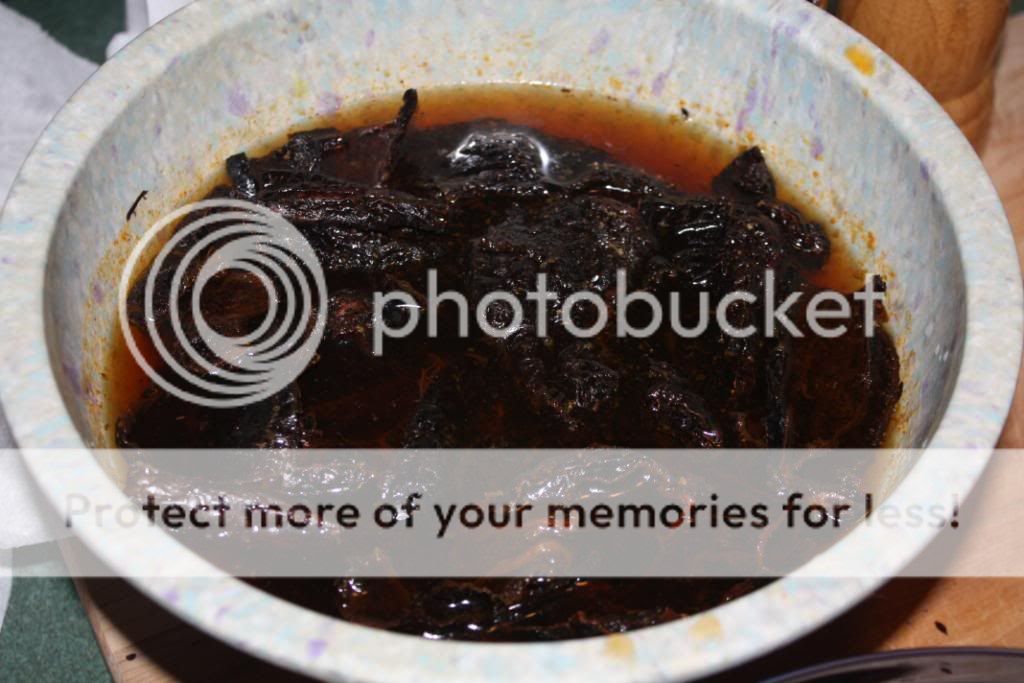My first taste of mole sauce was during our anniversary dinner this year at Topolobampo, Rick Bayless' restaurant just north of the loop. My entree was roasted lamb with black mole (or mole negro), the same mole sauce that a few weeks later won him the championship on Top Chef Masters. Mole sauce is a classic mexican sauce that comes in many varieties; red mole, green mole, peanut mole, mole poblano...each with it's own traditional ingredients and infinite personal variations. They are generally characterized by rich, complex flavor due to the large number of ingredients. Mole negro is the most complex and difficult to prepare (it can contain 30 or more ingredients).
I was browsing Bayless' website the a few days ago, after printing off his recipe for sopa azteca (tortilla soup, which I'll make next week), and happened across a recipe called"Lacquered Chicken" which sounded intriguing. The recipe calls for making a glaze out of red mole sauce, and applying it to baked chicken. I figured I could grill the chicken instead, and it would only be better. But first, I needed to make his classic red mole sauce (mole rojo clasico). The recipe makes a LOT of mole (three quarts). I only made one quart.
I headed off to a nearby mercado to pick up the mexican ingredients I wouldn't be able to find in the regular grocery store. Once I had everything I needed, I started the work of preparing everything. Red mole is less work than black mole, but it still has a lot of ingredients.

What you see here are three kinds of chiles; mulato, ancho and pasilla
also toasted bread, mexican chocolate, toasted sesame seeds, almonds, garlic, a tomatillo, raisins, anise seed, cloves, black pepper, cinnamon and lard. Not pictured are chicken stock, salt and sugar.
I worked out on the Big Green Egg, so we didn't all suffer the effects of frying chiles inside the house. I started by roasting the tomatillo until it was black and soft. Then I placed a small dutch oven over the coals, heated the lard and lightly fried the chiles, which had been seeded and cut into manageable pieces.


After the last batch of chiles were done, I fried the almonds and garlic, and then the raisins (not pictured). The chiles were soaked in water, to rehydrate them, and the almonds, garlic and raisins were added to the tomatillo, along with the sesame seeds, bread, chocolate and spices.



Once the chiles had rehydrated, they were blended with some of the soaking liquid, until smooth, and the resulting puree was returned to the hot pot, where it was reduced to a thick paste.

Meanwhile, the tomatillo mixture was pureed, and when the chile paste was reduced enough, the tomatillo puree was added and also reduced. Then the chicken stock was added, and again, the whole sauce was reduced to its finished consistency. Then salt and sugar were added.

The first dish I made with the sauce was grilled mahi-mahi, served with homemade guacamole and baked flour tortilla chips. The photo didn't turn out great, but the sauce was wonderful. I haven't had red mole before, so I can't say whether it tasted "authentic," but it tasted good to me, and Cori liked it, and that's all that really matters. It's amazing that, despite containing so many peppers (about a dozen), there's no heat to the sauce at all. Instead, it's the fruity flavor of the chiles that comes through, complemented by all the other ingredients, which blend together to make a delicious sauce with wonderful aroma and flavor...smokey, rich, and ever so slightly sweet.

As good as last night's mahi with mole was, the lacquered chicken tonight was even better. I see why mole is often served with chicken. They complemented each other wonderfully.

Mole takes a lot of time and effort. Next time I make it, I'll make a bigger batch and freeze some.
Many thanks to Chef Bayless for making his recipes available, and for kindly answering my questions. That he takes the time to teach and encourage his fans is truly remarkable.




No comments:
Post a Comment